 1
1 The question specifies the diameter of the screw, therefore the IMA of this screw is 0.812? / 0.318 = 8.02
 1
1  1
1  1
1  1
1 

It will provide an instant answer!
